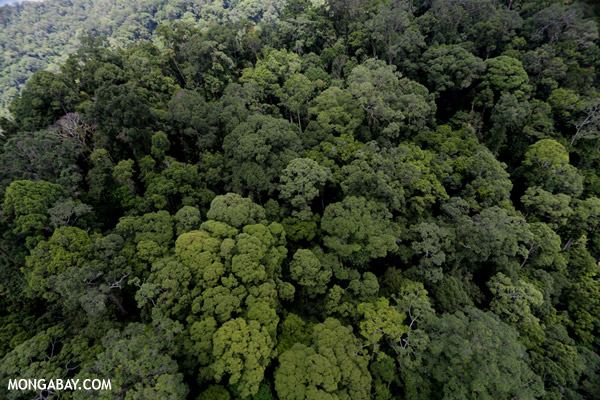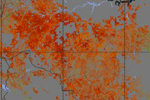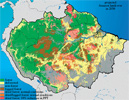
Tropical rainforest.
Faster plant growth due to higher concentrations of carbon dioxide may offset increased emissions from forest die-off in the tropics, asserts a new study based on climate modeling.
The research, published this week in the journal Nature, looks at how year-to-year variations in CO2 levels effect the long-term rate of carbon storage in tropical forests. It found that previous models may have overestimated the likelihood of forest die-back by assuming excessive variability in CO2 levels, while underestimating increased growth from CO2 fertilization. The study concludes that while tropical forests globally may release 53 billion tons of carbon for every degree Celsius of warming, they are likely to absorb a larger amount of carbon through more rapid growth.
“Fortunately, this carbon release is counteracted by the positive effects of carbon dioxide fertilization on plant growth under most scenarios of the 21st century, so that overall forests are expected to continue to accumulate carbon,” said lead author Peter Cox of the University of Exeter. Cox was also the lead author of a widely-cited 2000 paper that argued the Amazon was vulnerable to large-scale die-off by 2050 due to global warming.
However the paper did not incorporate the effects of deforestation and forest degradation, which can increase the incidence of drought, fire, and tree mortality. Nor did it factor in other greenhouse gases like methane, which warm the climate without boosting plant growth rates.
“We have been struggling for more than a decade to answer the question ‘will the Amazon forest die back under climate change?’ Our study indicates that the risk is low if climate change is associated with increased plant growth under elevated carbon dioxide,” said Cox. “But if this effect declines, or climate warming occurs due to something other than a carbon dioxide increase, we expect to see a significant release of carbon from tropical ecosystems”.
“The long-term health of tropical forests will depend on their ability to withstand multiple pressures from changing climate and deforestation,” added Chris Jones of the UK Met Office. “Our research has shed light on the former, but the latter remains a significant pressure on this ecosystem.”
The paper comes on the heels of other research suggesting that remote parts of the Amazon — far from deforested zones — are already experiencing large-scale die-off due to drought, the effects of may last years. Meanwhile another Nature study, published last November, warned that trees worldwide are more vulnerable to drought-stress than previously thought.
CITATION: Peter M. Cox et al. Sensitivity of tropical carbon to climate change constrained by carbon dioxide variability. Nature (2013) doi:10.1038/nature11882 Published online 06 February 2013
Related articles
Amazon rainforest failing to recover after droughts
(12/24/2012) The impact of a major drought in the Amazon rainforest in 2005 persisted far longer than previously believed, raising questions about the world’s largest tropical forest to cope with the expected impacts of climate change, reports a new study published in the journal Proceedings of the National Academy of Sciences.
Advanced technology reveals massive tree die-off in remote, unexplored parts of the Amazon

(12/12/2012) Severe drought conditions in 2010 appear to have substantially increased tree mortality in the Western Amazon, a region thought largely immune from the worst effects of changes occurring in other parts of the world’s largest rainforest, reported research presented last week at the fall meeting of the American Geophysical Union (AGU). The findings suggest that the Amazon may face higher-the-expected vulnerability to climate change, potentially undercutting its ability to help mitigate greenhouse gas emissions by absorbing carbon dioxide through faster growth.
Forests worldwide near tipping-point from drought

(11/23/2012) Forests worldwide are at ‘equally high risk’ to die-off from drought conditions, warns a new study published this week in the journal Nature. The study, conducted by an international team of scientists, assessed the specific physiological effects of drought on 226 tree species at 81 sites in different biomes around the world. It found that 70 percent of the species sampled are particularly vulnerable to reduction in water availability. With drought conditions increasing around the globe due to climate change and deforestation, the research suggests large swathes of the world’s forests — and the services they afford — may be approaching a tipping point.
Deforestation, climate change threaten the ecological resilience of the Amazon rainforest
(01/19/2012) The combination of deforestation, forest degradation, and the effects of climate change are weakening the resilience of the Amazon rainforest ecosystem, potentially leading to loss of carbon storage and changes in rainfall patterns and river discharge, finds a comprehensive review published in the journal Nature.
2010 Amazon drought released more carbon than India’s annual emissions
(10/09/2011) The 2010 drought that affected much of the Amazon rainforest triggered the release of nearly 500 million tons of carbon (1.8 billion tons of carbon dioxide) into the atmosphere, or more than the total emissions from deforestation in the region over the period, estimates a new study published in the journal Environmental Research Letters.
Climate change and deforestation pose risk to Amazon rainforest

(05/20/2011) Deforestation and climate change will likely decimate much of the Amazon rainforest, says a new study by Brazil’s National Institute for Space Research (INPE) and the UK’s Met Office Hadley Centre. Climate change and widespread deforestation is expected to cause warmer and drier conditions overall, reducing the resistance of the rainforest ecosystem to natural and human-caused stressors while increasing the frequency of extreme rainfall events and droughts by the end of this century. While climate models show that higher temperatures resulting from global climate change will threaten the resilience of the Amazon, current deforestation is an immediate concern to the rainforest ecosystem and is likely driving regional changes in climate.
Last year’s drought hit Amazon hard: nearly a million square miles impacted

(03/29/2011) A new study on its way to being published shows that the Amazon rainforest suffered greatly from last year’s drought. Employing satellite data and supercomputing technology, researchers have found that the Amazon was likely hit harder by last year’s drought than a recent severe drought from 2005. The droughts have supported predictions by the Intergovernmental Panel on Climate Change’s (IPCC) that climate change, among other impacts, could push portions of the Amazon to grasslands, devastating the world’s greatest rainforest. “The greenness levels of Amazonian vegetation—a measure of its health—decreased dramatically over an area more than three and one-half times the size of Texas and did not recover to normal levels, even after the drought ended in late October 2010,” explains the study’s lead author Liang Xu of Boston University.
Two massive droughts evidence that climate change is ‘playing Russian roulette’ with Amazon
(02/03/2011) In 2005 the Amazon rainforest underwent a massive drought that was labeled a one-in-100 year event. The subsequent die-off of trees from the drought released 5 billion tons of CO2. Just five years later another major drought struck. The 2010 drought, which desiccated entire rivers, may have been even worse according to a new study in Science, adding on-the-ground evidence to fears that climate change may inevitably transform the world’s greatest rainforest.
Drought threatens the Amazon rainforest as a carbon sink

(03/05/2009) Drought in the Amazon is imperiling the rainforest ecosystem and global climate, reports new research published in Science. Analyzing the impact of the severe Amazon drought of 2005, a team of 68 researchers across 13 countries found evidence that rainfall-starved tropical forests lose massive amounts of carbon due to reduced plant growth and dying trees. The 2005 drought — triggered by warming in the tropical North Atlantic rather than el Niño — resulted in a net flux of 5 billion tons of carbon dioxide (CO2) into the atmosphere — more than the combined annual emissions of Japan and Europe — relative to normal years when the Amazon is a net sink for 2 billion tons of CO2.
Half the Amazon rainforest will be lost within 20 years

(02/27/2008) More than half the Amazon rainforest will be damaged or destroyed within 20 years if deforestation, forest fires, and climate trends continue apace, warns a study published in Philosophical Transactions of the Royal Society B. Reviewing recent trends in economic, ecological and climatic processes in Amazonia, Daniel Nepstad and colleagues forecast that 55 percent of Amazon forests will be “cleared, logged, damaged by drought, or burned” in the next 20 years. The damage will release 15-26 billion tons of carbon into the atmosphere, adding to a feedback cycle that will worsen both warming and forest degradation in the region. While the projections are bleak, the authors are hopeful that emerging trends could reduce the likelihood of a near-term die-back. These include the growing concern in commodity markets on the environmental performance of ranchers and farmers; greater investment in fire control mechanisms among owners of fire-sensitive investments; emergence of a carbon market for forest-based offsets; and the establishment of protected areas in regions where development is fast-expanding.
Greenhouse gas emissions have already caused the Amazon to dry
(02/27/2008) Anthropogenic emissions of greenhouse gases have already caused the Amazon to dry, finds a new study published in Philosophical Transactions of the Royal Society B.
Small fires a big threat to Amazon rainforest biodiversity
(02/27/2008) Small fires have a big impact in the Amazon rainforest, report researchers writing in Philosophical Transactions of the Royal Society B. The findings suggest a dire future for Earth’s largest rainforest.
Amazon rainfall linked to Atlantic Ocean temperature
(02/25/2008) Climate models increasingly forecast a dire future for the Amazon rainforest. These projections are partly based on recent research that has linked drought in the Amazon to sea surface temperatures in the tropical Atlantic. As the tropical Atlantic warms, the southern Amazon — the agricultural heartland of Brazil — may see higher temperatures and less rainfall.
Large-scale Amazon deforestation or drying would have dire global consequences
(02/21/2008) A new study shows that large-scale degradation of the Amazon, either through drying or continued deforestation, would have global consequence, including worsening climate change, causing regional vegetation shifts, and increasing dust in the atmosphere.
Global warming – not el Nino – drove severe Amazon drought in 2005
(02/20/2008) One of the worst droughts on record in the Amazon was caused by high temperatures in the Atlantic rather than el Nino. The research, published in Philosophical Transactions of the Royal Society B, suggests that human-driven warming is already affecting the climate of Earth’s largest rainforest.